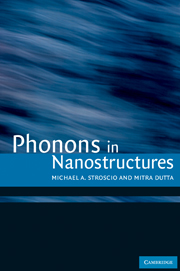Book contents
- Frontmatter
- Contents
- Preface
- Chapter 1 Phonons in nanostructures
- Chapter 2 Phonons in bulk cubic crystals
- Chapter 3 Phonons in bulk würtzite crystal
- Chapter 4 Raman properties of bulk phonons
- Chapter 5 Occupation number representation
- Chapter 6 Anharmonic coupling of phonons
- Chapter 7 Continuum models for phonons
- Chapter 8 Carrier–LO-phonon scattering
- Chapter 9 Carrier–acoustic-phonon scattering
- Chapter 10 Recent developments
- Chapter 11 Concluding considerations
- Appendices
- References
- Index
Chapter 11 - Concluding considerations
Published online by Cambridge University Press: 09 October 2009
- Frontmatter
- Contents
- Preface
- Chapter 1 Phonons in nanostructures
- Chapter 2 Phonons in bulk cubic crystals
- Chapter 3 Phonons in bulk würtzite crystal
- Chapter 4 Raman properties of bulk phonons
- Chapter 5 Occupation number representation
- Chapter 6 Anharmonic coupling of phonons
- Chapter 7 Continuum models for phonons
- Chapter 8 Carrier–LO-phonon scattering
- Chapter 9 Carrier–acoustic-phonon scattering
- Chapter 10 Recent developments
- Chapter 11 Concluding considerations
- Appendices
- References
- Index
Summary
Now there is one outstandingly important fact regarding Spaceship Earth, and that is that no instruction book came with it.
R. Buckminster Fuller, Operating Manual for Spaceship Earth, 1969Pervasive role of phonons in modern solid-state devices
As illustrated throughout this book, phonon effects are pervasive in modern solidstate devices. As is illustrated by the many examples for Chapters 7–10, the importance of these effects is usually at least as great for dimensionally confined structures as for bulk structures. Indeed, in Chapter 7 the effects of dimensional confinement were seen to be important even for biological structures! In this case, a cylindrical shell immersed in a fluid (Sirenko et al., 1996b) was used to model the vibrational behavior of microtubules (MTs) immersed in water. In addition, the examples of Chapters 7 and 9 illustrate that the elastic continuum model provides an accurate description of acoustic phonons in dimensionally confined structures of many geometries including thin films, nanowires with rectangular and circular cross sections, and a variety of dot-like structures. These structures will inevitably be pervasive as elements of nanoscale structures mimicking the well known and larger microelectromechanical structures. Indeed, Cleland and Roukes (1996) reported a technique for fabricating nanometer-scale mechanical structures from bulk, single-crystal Si substrates. As another example of acoustic phonon effects in dimensionally confined structures, it was recently predicted theoretically that Cerenkov-like effects lead to the generation of high-frequency confined acoustic phonons in quantum wells (Komirenko et al., 2000b); see Section 10.6.
In Chapter 8, values of carrier–optical-phonon scattering rates calculated for a variety of dimensionally confined semiconductor structures were found to exceed 1013 s–1.
- Type
- Chapter
- Information
- Phonons in Nanostructures , pp. 218 - 220Publisher: Cambridge University PressPrint publication year: 2001



